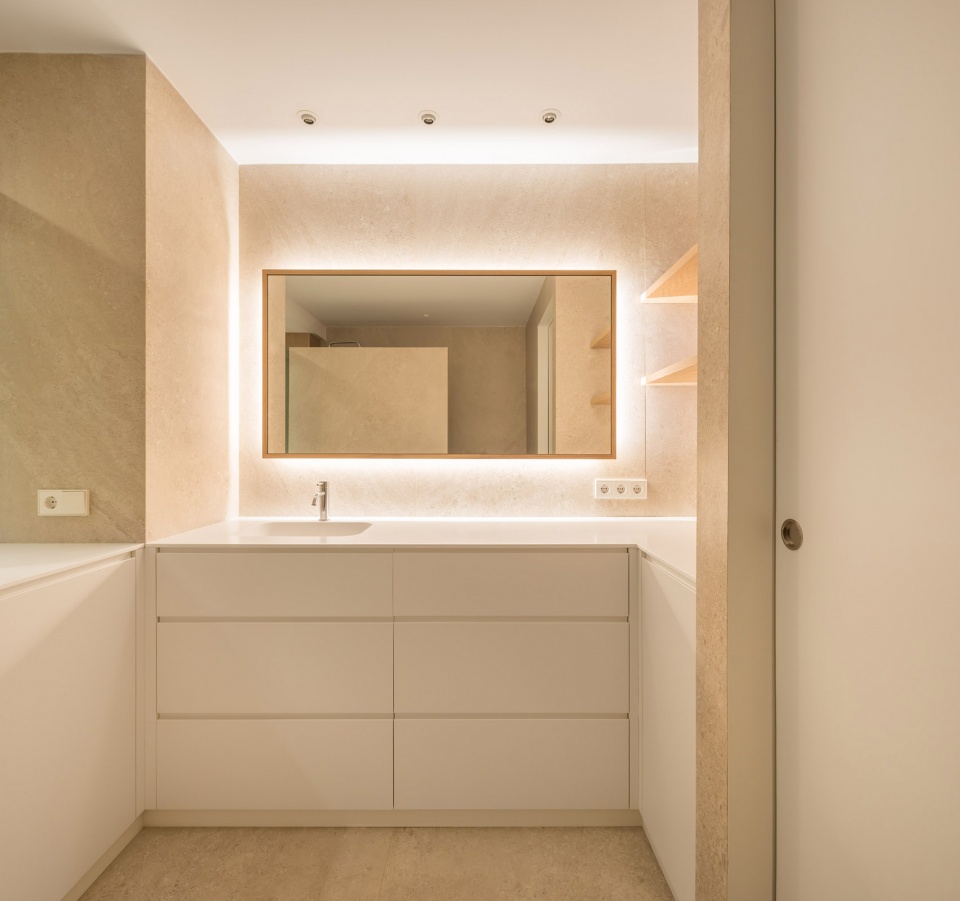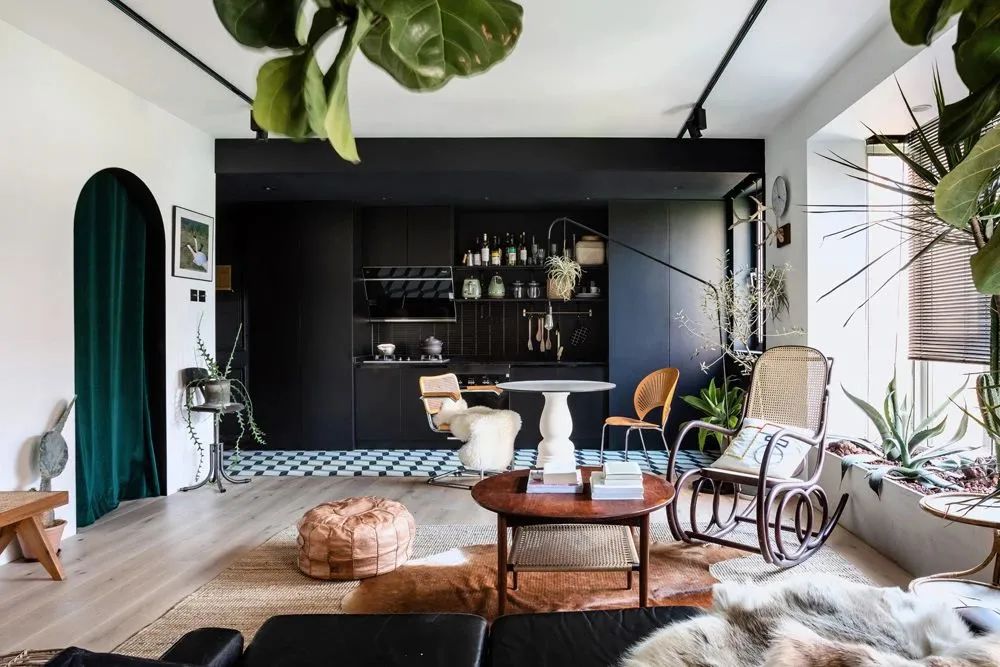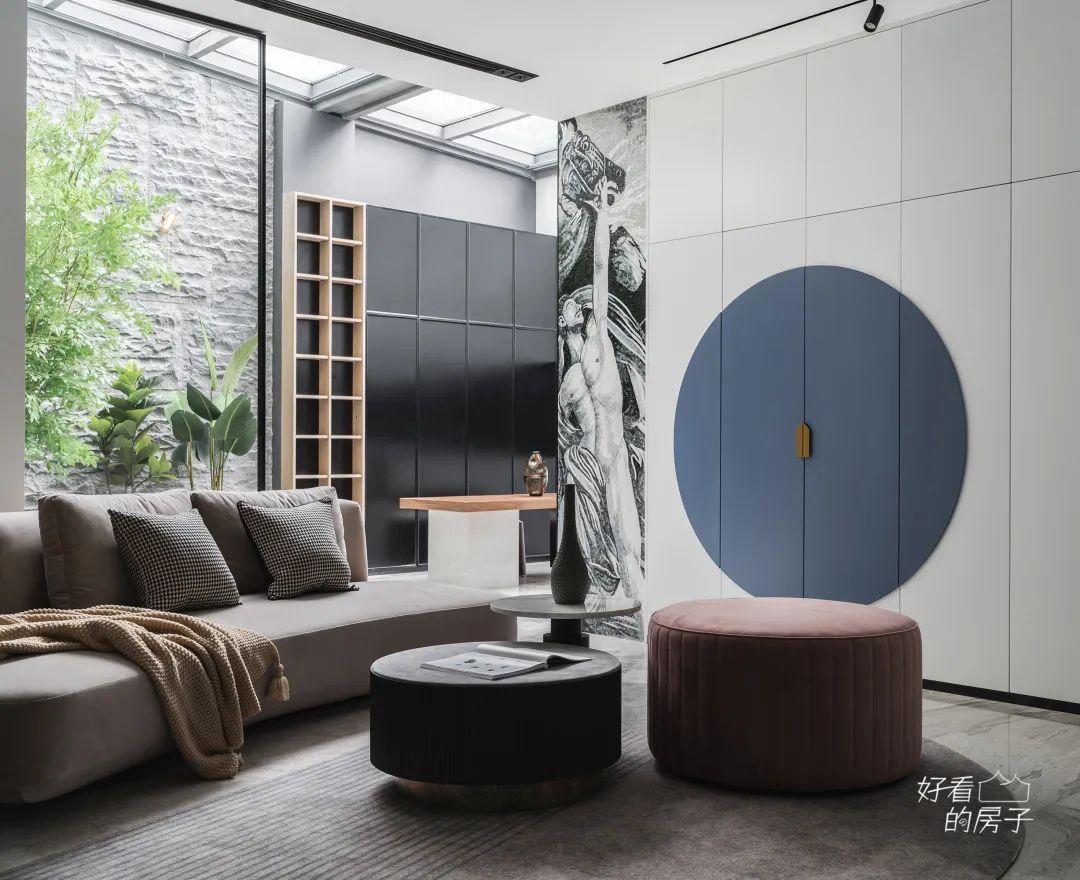

我们在巴伦西亚的Pla del Real地区,这里环境优越,南面是以前的河床——如今的Turia花园,西面是Monforte花园和Jardines del Real,也就是Viveros公园。这个住宅坐落于La Pagoda大楼内,这栋建筑依然矗立于此,因其历史和建筑设计而闻名于世。受日本传统建筑启发,建筑师Antonio Escario、José Vives和José Antonio Vidala于20世纪60年代初在从前的里帕尔达宫(Ripalda Palace)的废墟上建造了这栋楼,并很快成为巴伦西亚市的地标。
We’re in the Pla del Real district of Valencia, a privileged setting surrounded to the south by the former river bed —today the Turia Gardens— and to the west by the Monforte gardens and the Jardines del Real or Viveros park. The home is in La Pagoda no less, a building famous in the city for its history and architecture. Inspired by traditional Japanese architecture, it was built by architects Antonio Escario, José Vives and José Antonio Vidala in the early 1960s over the ruins of the former Ripalda Palace and soon became an icon of the city of Valencia.
▼住宅位于知名建筑项目La Pagoda公寓楼内,the home is in historic and famous La Pagoda building © Germán Cabo
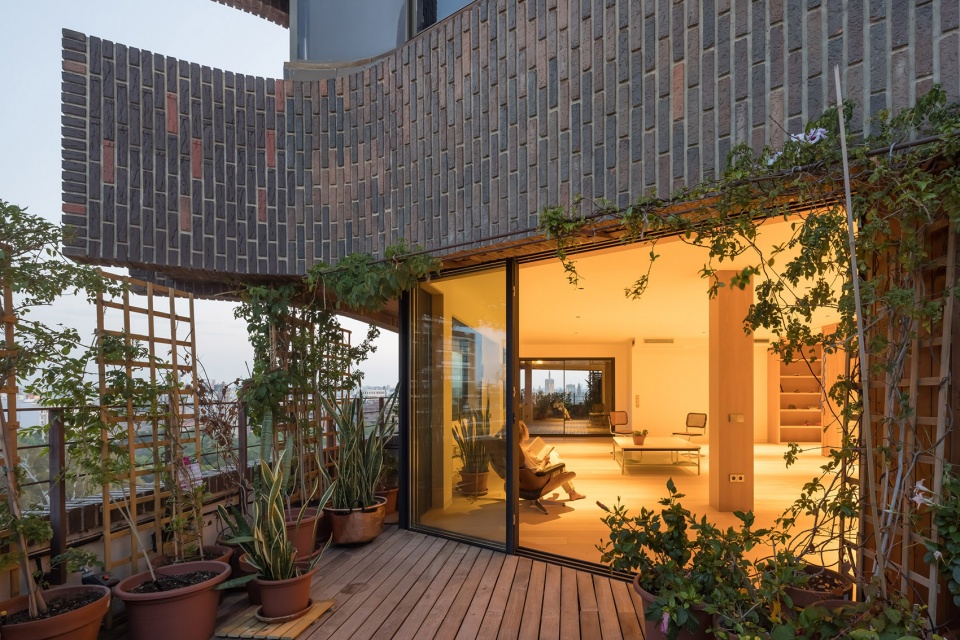
住宅的原始状态是一个大约270平米的大屋子,但它的各个房间被清晰有力地划分。我们决定设计一个平面不那么复杂的住宅,房间围绕视觉元素布置。
In its original state, it was a large home measuring approximately 270 m2, but its rooms were very compartmentalised. We decided to design a home with a less complex layout where rooms revolved around visual elements.
▼室内概览,overview of interior © Germán Cabo
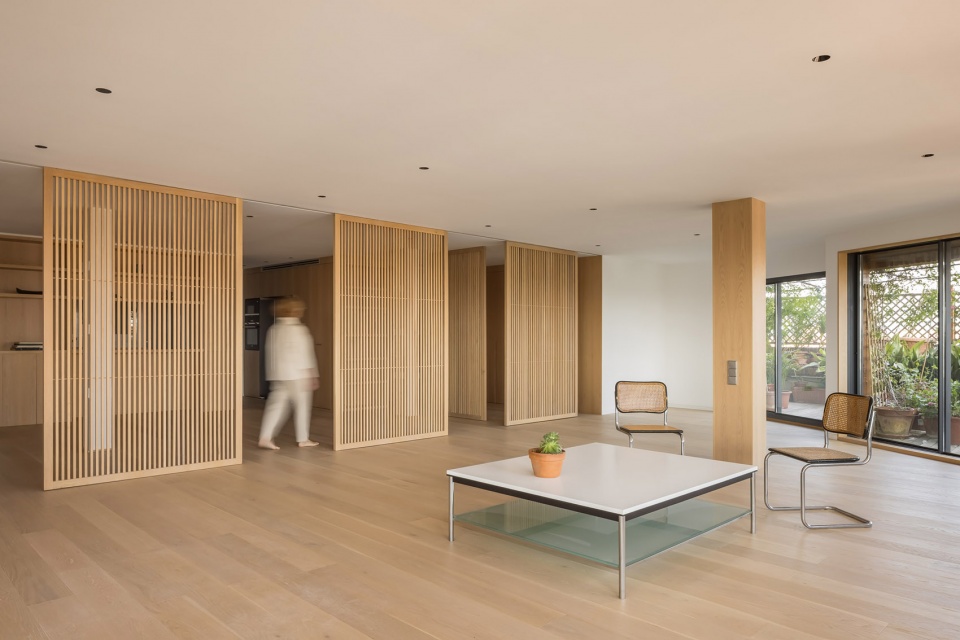
▼公寓入口,entrance of the aprtment © Germán Cabo
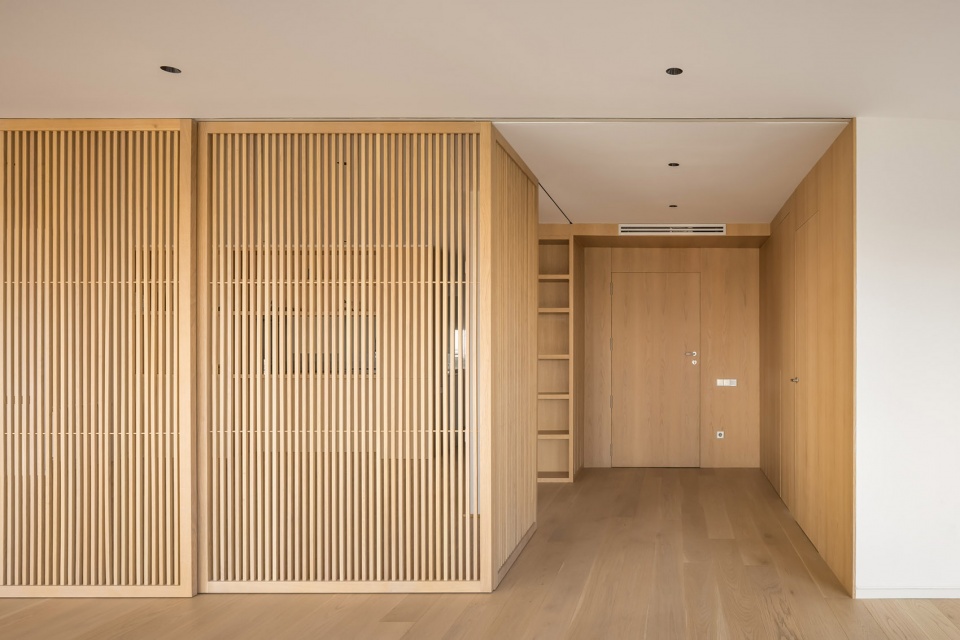
我们一开始深入这个项目,就将设计母题确定为木制滑门,它具有渗透性,为白天的空间带来透明性。这成为了项目的核心视觉元素。进入住宅后,你会看到一个由滑动门划分的大厅,可以根据居住者的需求意图,改变平面布局。这些木板还可以改变位置,为客厅、餐厅和厨房提供或多或少的隐私;它们可以以不同的角度倾斜,完全打开或完全关闭。
Once we delved into the project, we could say that the leitmotif was wooden sliders to afford permeability and transparency to the daytime spaces. These became the star visual element of the project. Entering the home leads you to a hall delimited by the sliders which can change its layout in regard to the other spaces according to the needs or intentions of those living in the property. These panels can also change position to lend more or less privacy in the living room, dining room and kitchen; they can be slanted at different angles, fully open or fully closed.
▼滑动木门灵活分隔空间,wooden sliders divide the space flexibly © Germán Cabo
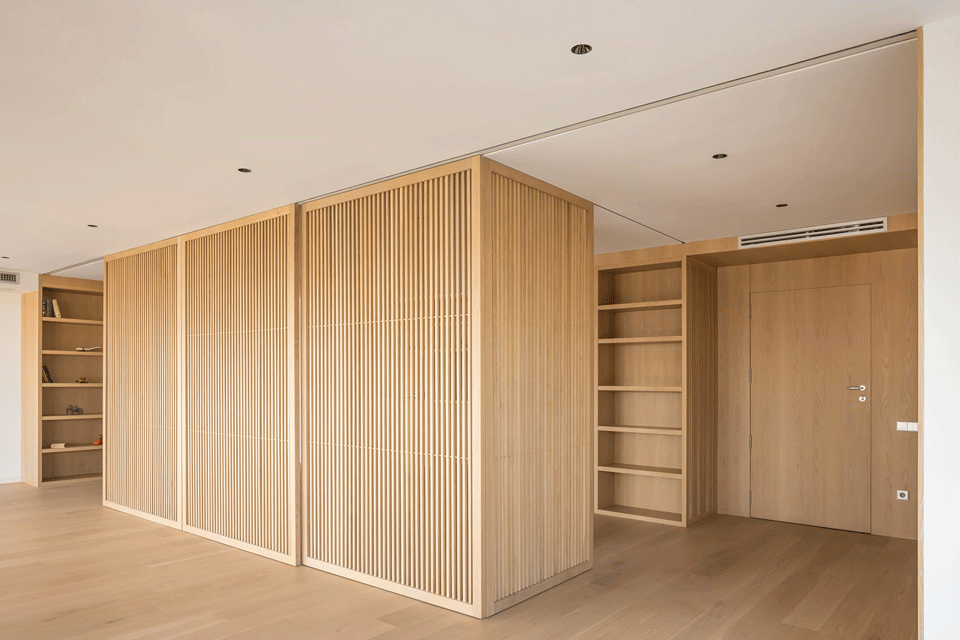
朝南的客厅在一天的大部分时间里都充满了光线,通过滑门可以从厨房看到这个始终明亮温暖的房间。然而,厨房没有直接光,因而总是比客厅要暗。这意味着厨房可以在滑门封闭时隐藏其后,提供隐私感。
The south-facing living room is filled with direct light throughout most of the day so the sliders mean you can view this room from the kitchen as it is always bright and light. The kitchen, however, receives no direct light and is always darker than the living room. This means that the kitchen can be concealed behind the closed sliders, lending a sense of privacy.
▼厨房概览,overview of the kitchen © Germán Cabo
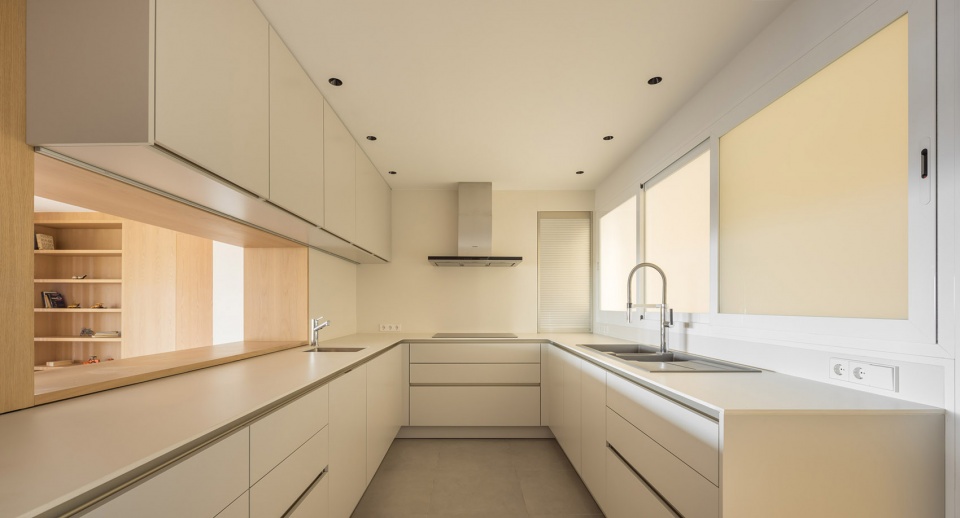
▼厨房没有直接光,比客厅更具隐私感,kitchen receives no direct light with more privacy © Germán Cabo
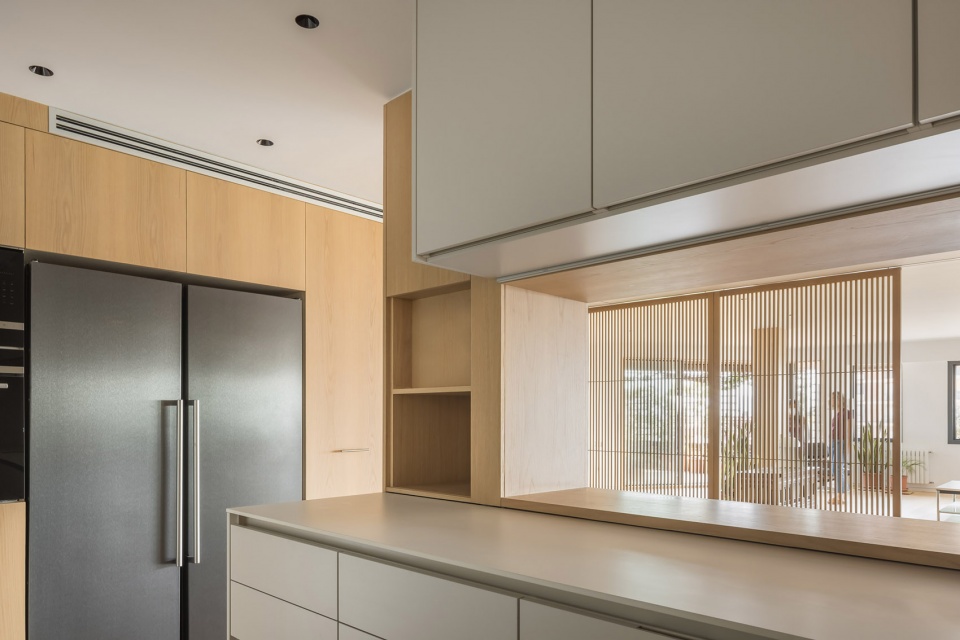
橡木遍布整个房子,不仅用于滑门,还被用于全屋地板(湿区除外),以及大厅的收纳柜、餐厅以及部分厨房空间,给这些区域带来温暖和宁静。用来连接厨房和客厅的家具也是由橡木制成;分隔空间的同时又将多种氛围融为一体,并提供能从厨房看到屋外的视野。
Oak wood unifies the project and is used not only on the sliders, but also on the flooring throughout the home (except in wet areas) as well as for storage in the hall, dining room and part of the kitchen, giving these areas warmth and serenity. The furniture used to connect the kitchen and living room is also made of oak; separating yet integrating the different ambiences created, and affording views to the exterior from the kitchen.
▼橡木在全屋广泛使用,Oak wood widely use throughout the home © Germán Cabo
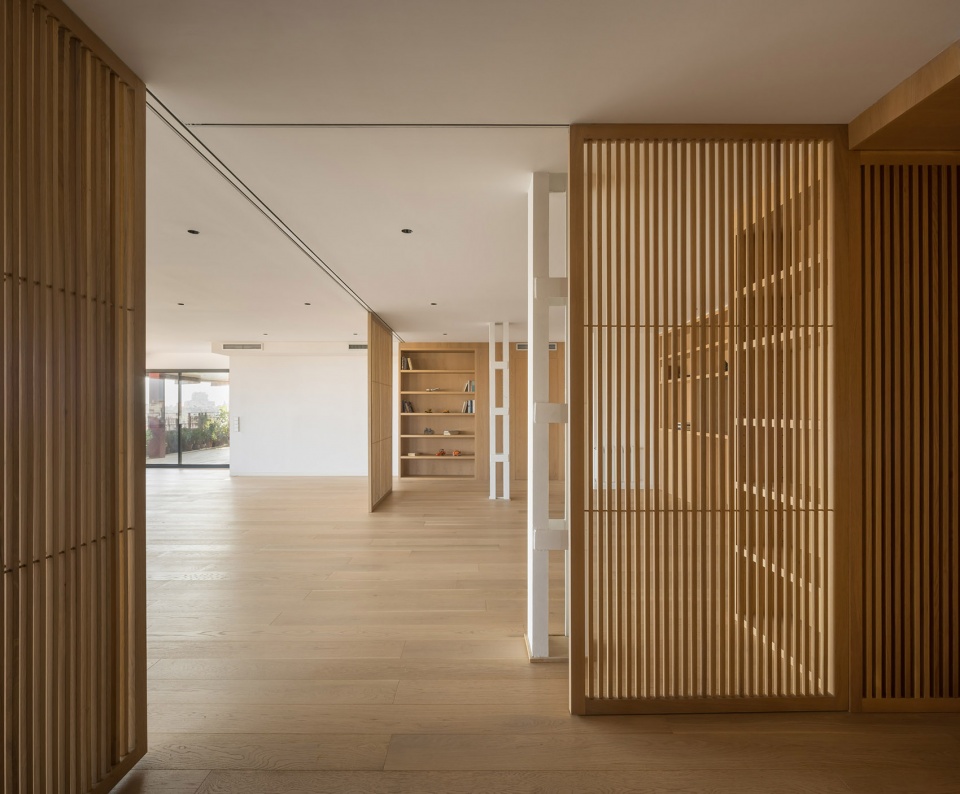
▼从卧室望向客厅,view from bedroom to living room © Germán Cabo
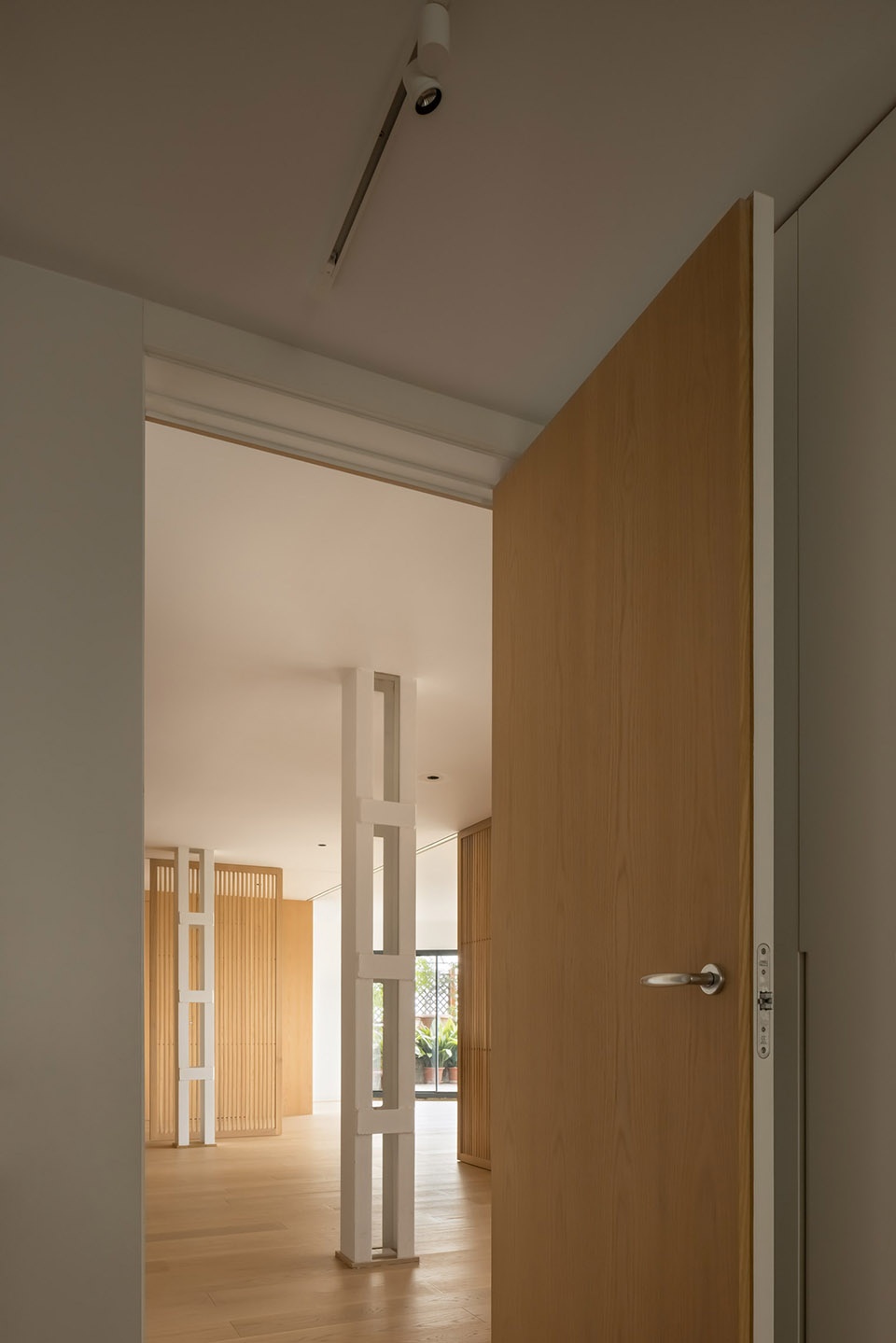
▼卧室区走廊,corridor in bedroom area © Germán Cabo
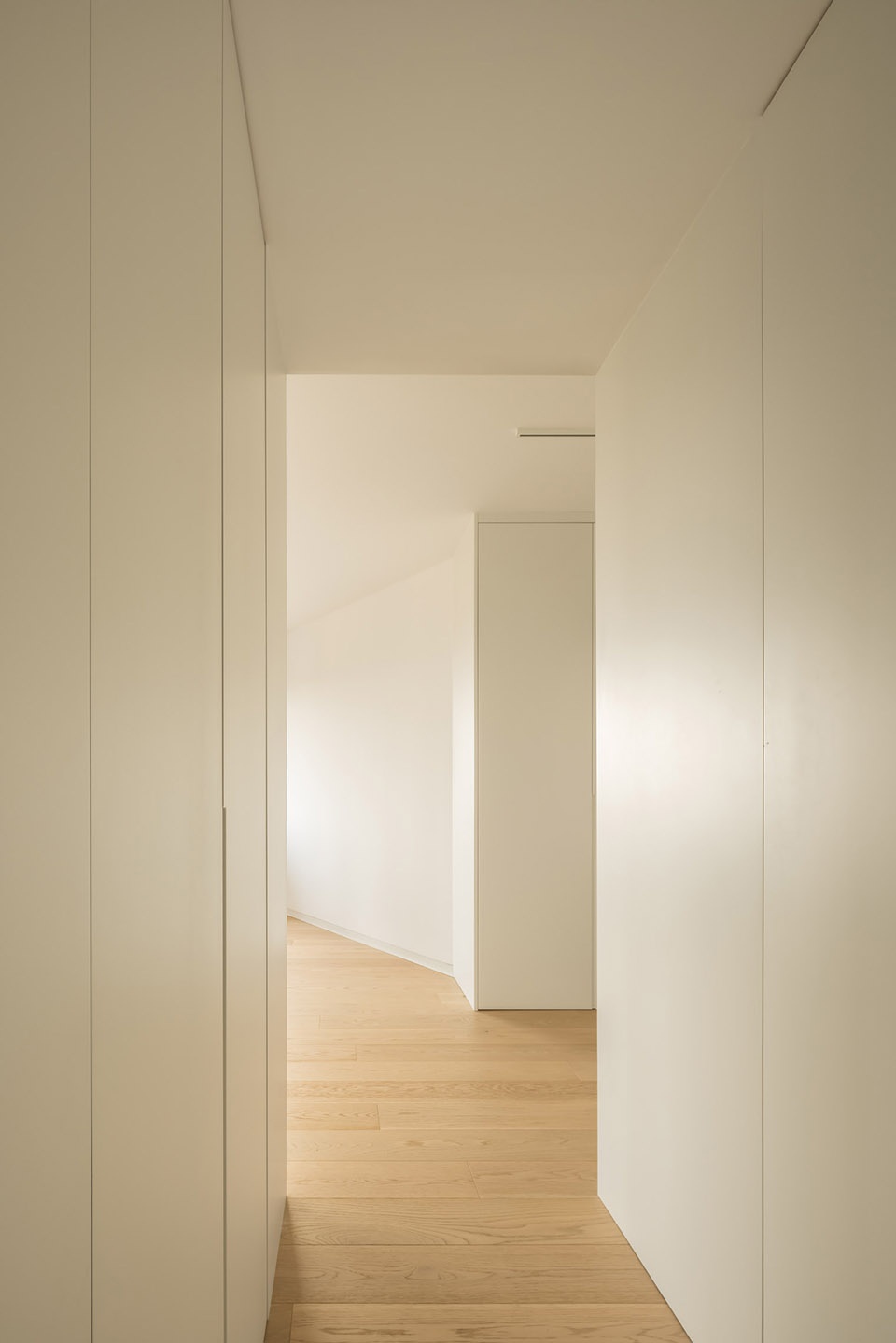
煤灰色的铝制外部门框与阳台地面同高,可以打开创造一个宽敞、通风和明亮的客厅。位于西南的夜间区域与起居室、餐厅和厨房的白天空间是分开的。走廊上布置有充足的收纳柜,通向4间卧室和3间卫生间。门和衣柜上的木工被设计得低调,没有线脚和节点装饰,向上直接连接到吊顶。卫生间朝向宽敞的内部庭院,保证通风。它们配有大型瓷器家具,所有其他元素均为白色,传达宁静感。在主卫中,干湿分离,水槽又与马桶和坐浴盆分开,使每个区域都是私密的。
Anthracite grey aluminium exterior carpentry is embedded at the same level as the terrace, which can be opened up to create a spacious, ventilated and luminous living room. The night-time area, to the south west, is separate from the daytime spaces of the living room, dining room and kitchen. Generous storage areas can be found in the corridor which leads to 4 bedrooms and 3 bathrooms. The carpentry on doors and wardrobes is designed to go unnoticed, with no joint embellishments, they are built up to the false ceiling. The bathrooms face onto a spacious inner courtyard providing ventilation. They will feature large porcelain fittings with all other elements in white to convey serenity. In the main bathroom, the shower is separate from the sink which is, in turn, separate from the WC and bidet, making each area private.
▼铝制煤灰色门框连通室内外,aluminum anthracite grey carpentry embrace terrace into interior © Germán Cabo
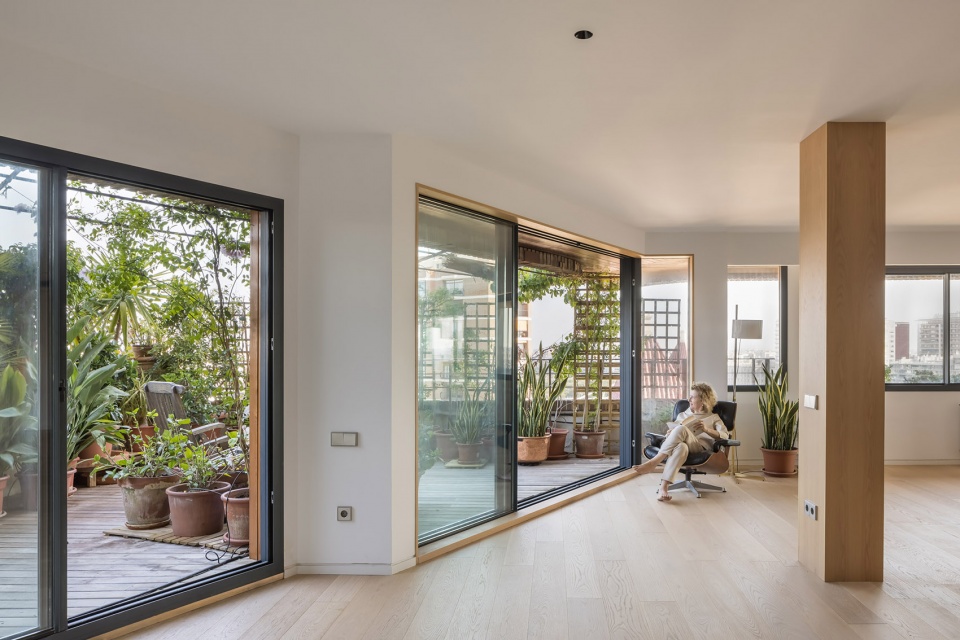
客厅的人工照明意在强化项目的主要理念。专用灯具和隐藏式光源直接照射到地板上,避免了恼人的光晕,因而天花板不会被照亮,也不会有反射光干扰屋子的视觉效果。这种感觉愉悦而均质,强调了木材的温暖,并确保了滑门在阳光直射和人造夜间光线下能投射出同样的阴影。
Artificial lighting in the living room seeks to enhance the main ideas of the project. Projected directly onto the flooring with technical luminaires and hidden light sources, thus avoiding an annoying halo of light around them so the ceiling goes unnoticed and no flashes interfere with the visuals of the home. The sensation is pleasant and homogeneous, highlighting the warmth of the wood and ensuring the sliders project the same shadows in direct sunlight and artificial night-time light.
▼客厅采用隐藏式照明系统,hidden light sources in the living room © Germán Cabo
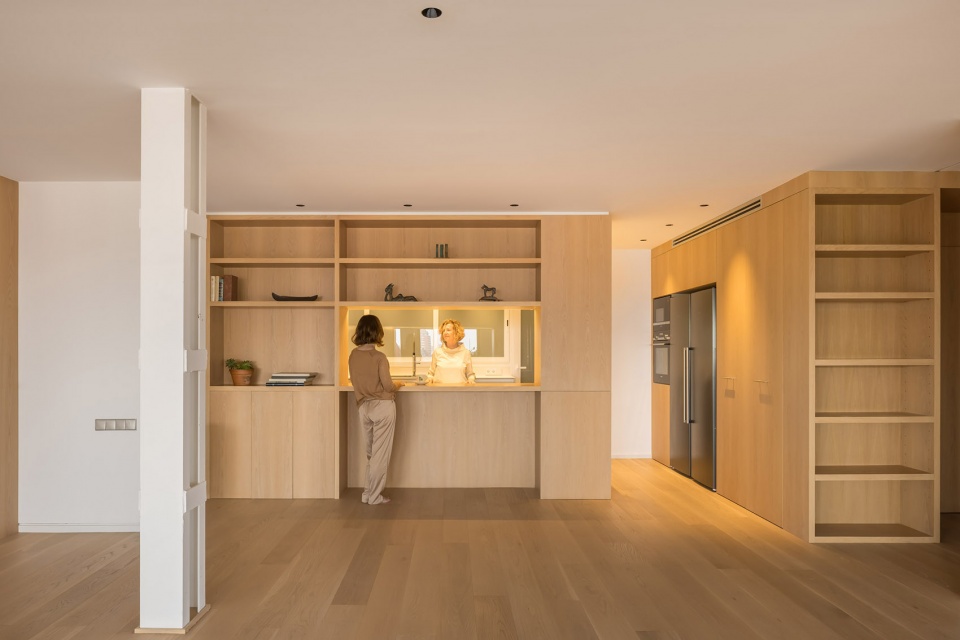
▼灯光设计强调了木材的温暖,并排除视觉干扰,lighting design highlight the warmth of the timber and ensures no interfere with the visuals © Germán Cabo
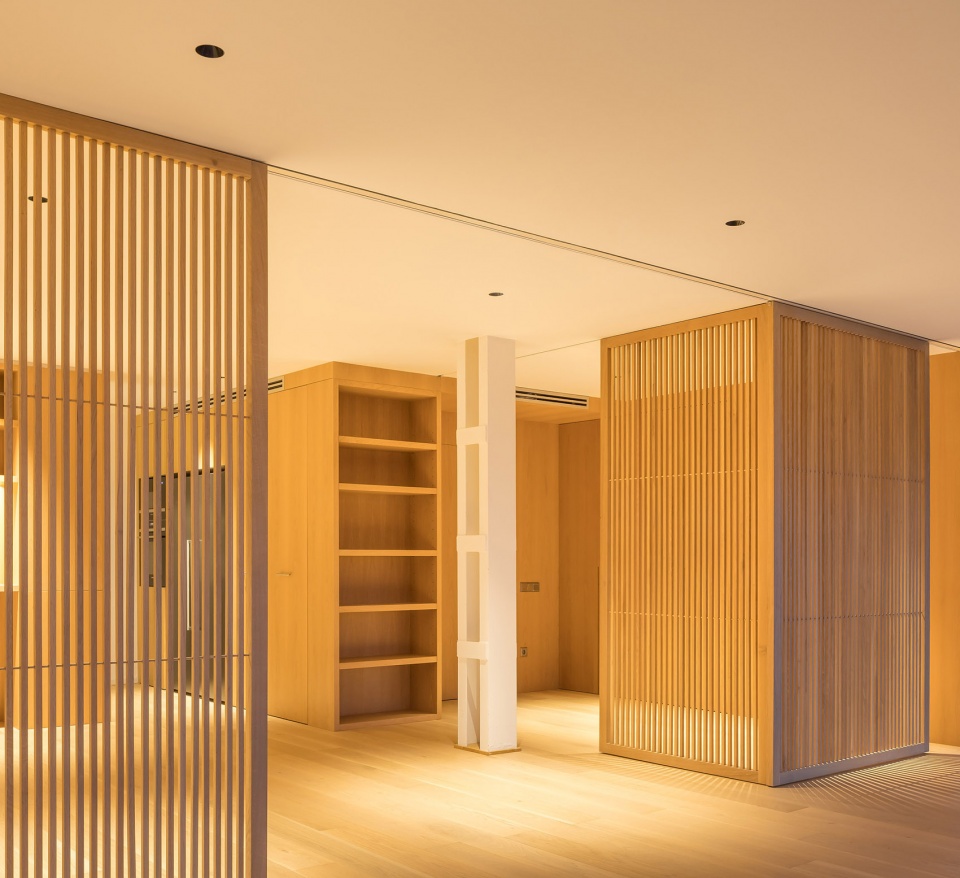
▼灯光下的木质滑门,wooden sliders under the light © Germán Cabo
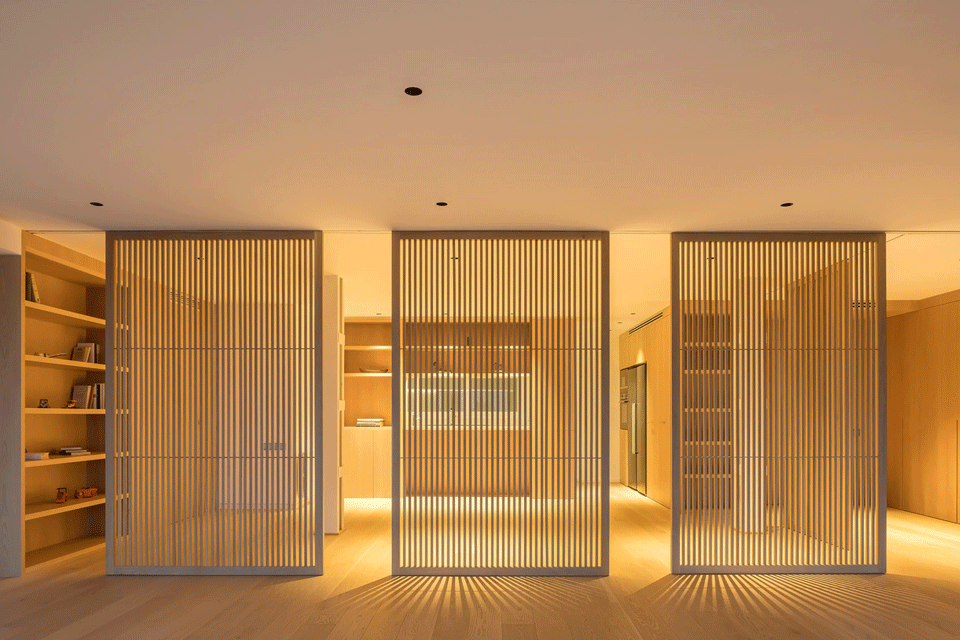
简而言之,与原来的强烈划分的空间布局相比,这是一个更简洁更一体的设计,使得项目的通透性、简单性和流动性成为关键语言。
In short, a simplified and unified design compared to the original home layout of compartmentalised spaces, resulting in a project where permeability, simplicity and fluidity are the keys to its discourse.
▼卫生间,bathroom © Germán Cabo
